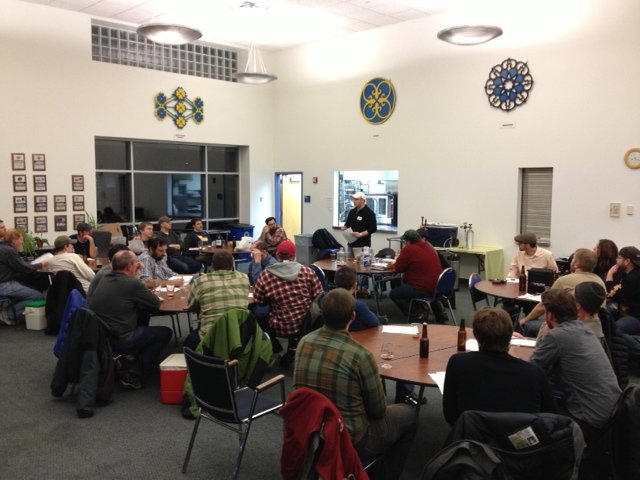 Longtime club member Andrew W. developed and delivered a presentation on understanding the affects of water pH for the homebrewer during our December 20th 2012 meeting. Here are the notes from his presentation (you can view the formatted .pdf with diagrams from Andrew’s presentation notes as well)
Longtime club member Andrew W. developed and delivered a presentation on understanding the affects of water pH for the homebrewer during our December 20th 2012 meeting. Here are the notes from his presentation (you can view the formatted .pdf with diagrams from Andrew’s presentation notes as well)
PART 1 — PRACTICAL GUIDE: Why is pH Important?
(see also: http://braukaiser.com/wiki/index.php?title=How_pH_affects_brewing)
- Tannin extraction increases as pH increases (i.e., more tannins extracted at pH 6 than pH 5).Usual mash pH is a non-issue for tannin extraction; sparging with alkaline water increases risk.
- Protein coagulation increases (i.e., will fall out of solution) as pH decreases.
- Beer color increases (i.e., darkens) as pH increases; keeping the boil pH in the ideal range will prevent excessive darkening in lighter beers.
- Starch conversion enzymes, in the mash, work optimally between a pH of 5.3 & 5.5; mash pH is still acceptable between 5.2 & 5.8.A mash pH that is too low will result in a thinner beer.
Where to Begin
Know-and build–your strike (mash) water: use (A) either reverse-osmosis water, distilled water, or your own, tested tap water.For your own water, see: http://www.wardlab.com/images/SampleForms/HomeBrewer.pdf
|
Na2+ |
Sodium |
Ca2+ |
Calcium |
Mg2+ |
Magnesium |
|
K2- |
Potassium |
CO32- |
Carbonate |
HCO3– |
Bicarbonate |
|
Cl- |
Chloride |
Fe2+ |
Iron |
SO42– |
Sulfate |
Know what beer you want to brew and plan ahead: know the malt weights, color (I..e, SRM), and style (i.e., base, crystal, roast, acid).Know your mash thickness (a thicker mash is easier to affect pH), but don’t forget about your sparge water!
Making Water
I recommend using the Bru’n Water tool, by Martin Brungard, to evaluate your mash pH options:See: https://sites.google.com/site/brunwater/
|
1a.Use RO/DI |
2a.Dilute tap water with RO/DI |
|
1b.Add minerals to RO/DI |
2b.Add minerals and/or acid |
|
1c.Add acid (e.g., lactic, phosphoric) |
- Chemical additions may include gypsum (CaSO4), calcium chloride (CaCl2), epsom salt (MgSO4), and/or baking soda (NaHCO3).I do not recommend using table salt (NaCl), pickling lime, or magnesium chloride (MgCl2).
- Recommended practice is to add chemicals, water, grains—in that order—to the mash tun.Evaluate actual mash pH versus target, if desired.
- Dark malt is more acidic than light malt: lighter-colored beers generally favor approach No. 1; darker beers favor approach No. 2.
Other Tidbits
- Convention is to report pH at room temperature.pH will change with temperature, and ATC will correct for it, but the published, optimum pH range of 5.3 to 5.5 is when at room temp, so you’d need to readjust thepH reference range for your sample temperature.
- A finished beer’s low pH (<4.5) is a significant factor in why it is “safe to drink.”
- A finished beer’s lower pH (relatively speaking) reportedly results in a livelier, crisper flavor; higher pH in finished beer reportedly dulls the flavor.
- A finished beer is said to have more pronounced hop character with a higher sulfate:chloride ratio, and a more pronounced malty character with a lower sulfate:chloride ratio.
- Five Star Chemicals product “5.2” does not work.
NOTE: mash pH is only a concern of the all-grain brewer. That said, water characteristics are still important for the extract brewer, but we can greatly simplify that down to one bit of advice: as a rule of thumb, generally aim to use RO or DI water with extract brewing.
PART 2 — A Slightly IMPRACTICAL GUIDE to Water and your Mash pH:
What is ‘pH’?
- A measurement of the activity of the hydrogen ion in solution (i.e., the acidity of a solution).
- Measured on a log scale: a pH “5” solution has ten times the hydrogen as a pH “6” solution.
Mash at the Molecular Level
- The act of adding malt/grains to water causes a chemical reaction which releases (adds) protons (i.e., decreases pH).A proton is represented as H+.
- The act of adding salts (e.g., CaSO4, MgCl2) provides additional reagents for the aforementioned reaction, producing additional protons and decreasing pH.
- Mash pH is influenced by the H+ vs OH– concentration; higher H+ concentration means a lower pH. Bicarbonates (HCO3–) and carbonates (CO32-) in water will react with free hydrogen (H+) to form water (H2O) and carbon dioxide (CO2), resulting in an overall decrease in H+ concentration (i.e. raising pH).
H++HCO3–→H2O + CO2
2H++CO32- →H2O + CO2
- Malt contains 1% phosphate by weight, 80% of which ends up in the wort; Calcium & Magnesium become the limiting reagents.
- Not all Ca2+ & Mg2+ protons are used in the phosphate reaction.Approx. 29% of available Ca2+ is used, compared to approx. 14% of available Mg2+.
What does this mean?
- Adding calcium-containing and magnesium-containing salts will result in a lower pH.
- Adding hydroxide-containing (OH–) and carbonate-containing chemicals will result in a higher pH.
- Adding acid—the brute force method, direct H+ injection—as either Lactic (88%) or as phosphoric (10%), will result in a lower pH.I’ve observed that a just a few milliliters of lactic acid (88%) in the mash can greatly influence pH without imparting any flavor.
